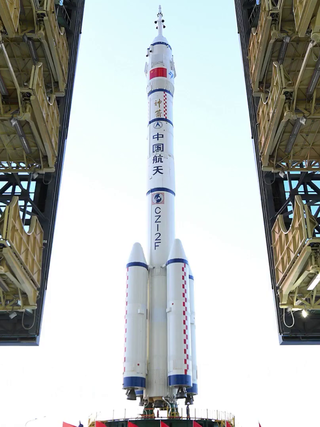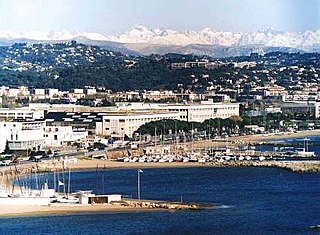Related Research Articles
The Long March rockets are a family of expendable launch system rockets operated by the China Aerospace Science and Technology Corporation. The rockets are named after the Chinese Red Army's 1934–35 Long March military retreat during the Chinese Civil War.

Spaceflight is an application of astronautics to fly spacecraft into or through outer space, either with or without humans on board. Most spaceflight is uncrewed and conducted mainly with spacecraft such as satellites in orbit around Earth, but also includes space probes for flights beyond Earth orbit. Such spaceflight operates either by telerobotic or autonomous control. The more complex human spaceflight has been pursued soon after the first orbital satellites and has reached the Moon and permanent human presence in space around Earth, particularly with the use of space stations. Human spaceflight programs include the Soyuz, Shenzhou, the past Apollo Moon landing and the Space Shuttle programs, with currently the International Space Station as the main destination of human spaceflight missions while China's Tiangong Space Station is under construction.

The Long March 2F, also known as the CZ-2F, LM-2F and Shenjian, is a Chinese orbital carrier rocket, part of the Long March 2 rocket family. Designed to launch crewed Shenzhou spacecraft, the Long March 2F is a human-rated two-stage version of the Long March 2E rocket, which in turn was based on the Long March 2C launch vehicle. It is launched from complex SLS at the Jiuquan Satellite Launch Center. The Long March 2F made its maiden flight on 19 November 1999, with the Shenzhou 1 spacecraft. After the flight of Shenzhou 3, CPC General Secretary and President Jiang Zemin named the rocket "Shenjian" meaning "Divine Arrow".
International Traffic in Arms Regulations (ITAR) is a United States regulatory regime to restrict and control the export of defense and military related technologies to safeguard U.S. national security and further U.S. foreign policy objectives.
Apstar 6 is a communications satellite built by Alcatel Space, a subsidiary of Alcatel, and was boosted into orbit on April 12, 2005, by Long March 3B launcher from Xichang Satellite Launch Center in China. It provides APT Satellite, a satellite operator in the Asia Pacific region, with broadband media and television services. It is fitted with 38 C-band transponders and 12 Ku band transponders. China is covered with a dedicated high power Ku band beam for broadband multimedia transmission. It is the second model of the Spacebus 4000. The transponders have a reduced C-band receiving dish over a wide footprint, which extends across India, China and Australia.

The Office of Commercial Space Transportation is the branch of the United States Federal Aviation Administration (FAA) that approves any commercial rocket launch operations — that is, any launches that are not classified as model, amateur, or "by and for the government" — in the case of a U.S. launch operator and/or a launch from the U.S.
This is a list of the satellites operated by Optus, an Australian telecommunications company. The satellite communications facility is located at Belrose on Sydney's Northern Beaches. Optus' satellites are divided into 4 classes A, B, C and D. As of April 2014 it owns and operates Optus B3, Optus C1, Optus D1, Optus D2 and Optus D3. Optus A1, Optus A2, Optus A3 and Optus B1 satellites have been retired. Optus has the largest network of satellites in Australia and New Zealand.
Long March 2 rocket family or Chang Zheng 2 rocket family as in Chinese pinyin is an expendable launch system operated by the People's Republic of China. The rockets use the abbreviations LM-2 family for export, and CZ-2 family within China, as "Chang Zheng" means "Long March" in Chinese pinyin. They are part of the larger Long March rocket family. Development and design falls mostly under the auspices of the China Academy of Launch Vehicle Technology (CALT).

Intelsat 708 was a telecommunications satellite built by the American company Space Systems/Loral for Intelsat. It was destroyed on February 15, 1996 when the Long March 3B launch vehicle failed while being launched from the Xichang Satellite Launch Center in China. The launch vehicle veered off course immediately after liftoff and struck a nearby village, officially killing at least six people.

The Space & Upper Atmosphere Research Commission (SUPARCO) is the executive and national space agency of Pakistan. It is headquartered at the capital city of Islamabad in the northern part of Pakistan with additional facilities at the University of Punjab in Lahore.
AsiaSat 2 was a Hong Kong communications satellite, which was owned, and was initially operated, by the Hong Kong based Asia Satellite Telecommunications Company. It was positioned in geostationary orbit at a longitude of 17° East of the Greenwich Meridian, on lease to Spacecom. It spent most of its operational life at 100.5° East, from where it was used to provide fixed satellite services, including broadcasting, audio and data transmission, to Asia and the Pacific Ocean.

Thales Alenia Space is a Franco-Italian aerospace manufacturer. A joint venture between the French technology corporation Thales Group (67%) and Italian defense conglomerate Leonardo (33%), the company is the largest satellite manufacturer in Europe. It is headquartered in Cannes, France.
ChinaSat is the brand name of communications satellites operated by China Satellite Communications.
The Long March 3B, also known as the CZ-3B and LM-3B, is a Chinese orbital launch vehicle. Introduced in 1996, it is launched from Launch Area 2 and 3 at the Xichang Satellite Launch Center in Sichuan. A three-stage rocket with four strap-on liquid rocket boosters, it is currently the second most powerful member of the Long March rocket family after the Long March 5 and the heaviest of the Long March 3 rocket family, and is mainly used to place communications satellites into geosynchronous orbits.
The Long March 2E, also known as the Chang Zheng 2E, CZ-2E and LM-2E, was a Chinese orbital carrier rocket from the Long March 2 family. The Long March 2E was a three-stage carrier rocket that was designed to launch commercial communications satellites into geosynchronous transfer orbit. Launches took place from launch complex 2 at the Xichang Satellite Launch Center.

The space policy of the United States includes both the making of space policy through the legislative process, and the implementation of that policy in the United States' civilian and military space programs through regulatory agencies. The early history of United States space policy is linked to the US–Soviet Space Race of the 1960s, which gave way to the Space Shuttle program. At the moment, the US space policy is aimed at the exploration of the Moon and the subsequent colonization of Mars.
Apstar-7 is a Chinese communications satellite which is operated by APT Satellite as part of the Apstar system. It was launched in 2012 as a replacement for the Apstar 2R satellite launched in 1997.

Orbital-3, also known as Orb-3, was an attempted flight of Cygnus, an automated cargo spacecraft developed by United States-based company Orbital Sciences, on 28 October 2014. The mission was intended to launch at 22:22:38 UTC that evening. This flight, which would have been its fourth to the International Space Station and the fifth of an Antares launch vehicle, resulted in the Antares rocket exploding seconds after liftoff.

The space policy of the Donald Trump administration, as of December 2020, comprises five Space Policy Directives and an announced "National Space Strategy", representing a directional shift from the policy priorities and goals of his predecessor, Barack Obama. A National Space Policy was issued on December 9, 2020.
References
- ↑ APStar
- ↑ "Timeline: China's spaceflight history". NewScientist. 12 October 2005.
- 1 2 3 4 Zinger, Kurtis J. (26 October 2014). "An Overreaction that Destroyed an Industry: The Past, Present, and Future of U.S. Satellite Export Controls" (PDF). University of Colorado Law Review. 86 (1): 351–387. Archived (PDF) from the original on 24 January 2021.
- 1 2 Zelnio, Ryan (January 9, 2006). "A short history of export control policy". The Space Review.
- ↑ de Selding, Peter B. (April 14, 2016). "U.S. ITAR satellite export regime's effects still strong in Europe". SpaceNews.